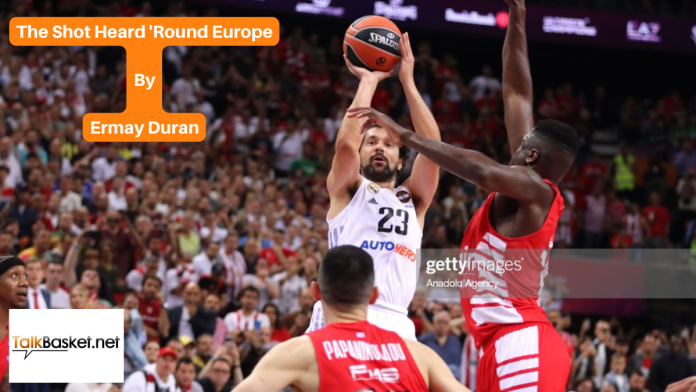
On May 21st, 2023, fans around the world held their breath as the Euroleague Final Four came down to a nail-biting finish between Real Madrid and Olympiacos. With a score of 79-78 in favor of Real Madrid, the game was a battle of wits and wills, featuring an incredible lead changes and zone offense that will be seen much more in the next season. But it was a particular moment – a split-second decision – that stole the spotlight. Sergio Llull, who had played minimal minutes on the court, stepped up and took an amazing mid-range shot that sealed the victory for Real Madrid.
Basketball, at its core, is a game of decisions. Every pass, every shot, every defensive play is a decision that can alter the trajectory of the game. But some decisions hold more weight than others, especially those made in the final moments of a closely contested match. These are the moments that separate the good players from the great ones, and it’s precisely in these moments that the research of Patrick McFarlane becomes essential.
In his paper, “Evaluating NBA End-of-Game Decision-Making,” McFarlane introduces a probabilistic method to assess the tactical decisions made by players and coaches during the final moments of NBA games. McFarlane’s research was a crucial part of my master’s study in psychology, where I focused on decision-making in basketball. His End-of-Game Tactics Metric (ETM) measures how much better or worse a team’s decision was compared to what would have been considered optimal, using a win probability model built with logistic regression and player statistics. This model considers factors such as time remaining, score differential, possession, and point spread to estimate each team’s chances of winning at any given moment.
Applying McFarlane’s model to Llull’s decision, one could argue that his shot was a high-risk, high-reward play. With minimal time on the court, Llull had little room for error. However, his decision to take the shot was not just brave but also smart. Had he passed the ball, there’s a chance that the play could have been broken up, or a less capable shooter might have missed. But Llull took the shot, despite the pressure, and that decision won the game for Real Madrid.
McFarlane’s research also provides insights into specific strategies used by teams during end-of-game scenarios. For instance, intentionally fouling while leading can be an effective strategy if executed correctly. Specifically, he found that fouling with less than nine seconds remaining is the optimal decision, as it leaves the trailing team with little time to intentionally foul themselves and regain possession. Similarly, intentionally fouling while trailing can also be effective, but only if executed correctly. Fouling with more than 30 seconds remaining is generally not a good decision, as it gives the leading team too much time to score again and extend their lead.
The story of Llull’s shot is a testament to the importance of decisive, calculated decision-making in basketball. It’s not just about physical skill or sheer luck; it’s about understanding the game, assessing the situation, and making the right call. And sometimes, as Llull demonstrated, it’s about having the courage to take the shot when it matters most. After all, as the old saying goes, “You miss 100% of the shots you don’t take.”
McFarlane’s research is not only useful for understanding the past, but it can also serve as a tool for teams and players to refine their strategies in real time. By considering factors such as time remaining, score differential, and possession,teams can make more informed decisions, potentially increasing their chances of success in crucial moments of the game.
Despite the stress and immense pressure that comes with the final moments of a tightly contested game, players like Llull demonstrate the power of resilience and mental fortitude. These moments are what make basketball so thrilling and why we, as fans, remain glued to our seats till the last second.
In conclusion, basketball is not merely a physical sport. It is a game of decisions where mental prowess often trumps physical abilities. Understanding this aspect of the game and using tools like McFarlane’s ETM can help players and teams make better decisions, turning moments of high pressure into moments of glory.
So, the next time you watch a game, pay attention to the decisions that players make, especially in the final moments. These are the moments that define not just the outcome of the game, but also the legacy of the players. And who knows?
You might just witness another unforgettable shot like Sergio Llull’s.
Remember, the beauty of basketball lies not just in the swish of the net or the roar of the crowd, but in the split-second decisions that lead to these moments. These decisions reveal the player’s understanding of the game, their courage under pressure, and their ability to seize the moment when it matters most. This is the art of clutch decision-making in basketball, beautifully exemplified by Sergio Llull in the Euroleague Final Four 2023.
And as we continue to enjoy this beautiful game, let’s also appreciate the mental aspects of it. The game is not just about the physicality and skills of the players, but also about the decisions they make under pressure and the strategies they employ to win. The more we understand these aspects, the more we can appreciate the beauty and complexity of basketball.
So, here’s to the players who make the tough decisions.
If you’d like to check out the stats of the game from a different perspective check Viziball out:
https://viziball.app/game/euroleague/en/olympiacos/real/20230521

















